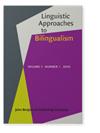The importance of features and exponents
IF 1.8
2区 文学
0 LANGUAGE & LINGUISTICS
引用次数: 3
Abstract
Formal approaches to bi- and multilingual grammars rely on two important claims: (i) the grammatical architecture should be able to deal with mono- and bi-/multilingual data without any specific constraints for the latter, (ii) features play a pivotal role in accounting for patterns across and within grammars. In the present paper, it is argued that an exoskeletal approach to grammar, which clearly distinguishes between the underlying syntactic features and their morphophonological realizations (exponents), offers an ideal tool to analyze data from bi- and multilingual speakers. Specifically, it is shown that this framework can subsume the specific mechanism of Feature Reassembly developed by Donna Lardiere since the late 1990’s. Three case studies involving different languages and language combinations are offered in support of this claim, demonstrating how an exoskeletal approach can be employed without any additional constraints or mechanisms.特征和指数的重要性
双语和多语语法的形式化方法依赖于两个重要的主张:(i) 语法结构应该能够处理单语和双语/多语数据,而对后者没有任何特定的限制;(ii) 特征在解释跨语法和语法内部的模式方面起着关键作用。本文认为,外骨骼语法清晰地区分了基本的句法特征及其形态音素实现(指数),为分析来自双语和多语使用者的数据提供了理想的工具。具体而言,研究表明这一框架可以包含唐娜-拉迪尔(Donna Lardiere)自 20 世纪 90 年代末以来开发的 "特征重组"(Feature Reassembly)具体机制。本文提供了三个涉及不同语言和语言组合的案例研究来支持这一观点,展示了如何在没有任何额外限制或机制的情况下使用外骨骼方法。
本文章由计算机程序翻译,如有差异,请以英文原文为准。
求助全文
约1分钟内获得全文
求助全文
来源期刊

Linguistic Approaches To Bilingualism
Social Sciences-Linguistics and Language
CiteScore
3.20
自引率
9.10%
发文量
24
期刊介绍:
LAB provides an outlet for cutting-edge, contemporary studies on bilingualism. LAB assumes a broad definition of bilingualism, including: adult L2 acquisition, simultaneous child bilingualism, child L2 acquisition, adult heritage speaker competence, L1 attrition in L2/Ln environments, and adult L3/Ln acquisition. LAB solicits high quality articles of original research assuming any cognitive science approach to understanding the mental representation of bilingual language competence and performance, including cognitive linguistics, emergentism/connectionism, generative theories, psycholinguistic and processing accounts, and covering typical and atypical populations.
 求助内容:
求助内容: 应助结果提醒方式:
应助结果提醒方式:


